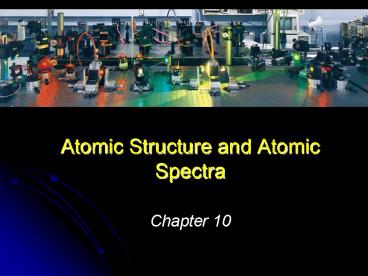Atomic Structure and Atomic Spectra - PowerPoint PPT Presentation
1 / 20
Title:
Atomic Structure and Atomic Spectra
Description:
Title: No Slide Title Author: Deborah Last modified by: Will Wickun Created Date: 9/17/2001 11:32:47 PM Document presentation format: On-screen Show (4:3) – PowerPoint PPT presentation
Number of Views:508
Avg rating:3.0/5.0
Title: Atomic Structure and Atomic Spectra
1
Atomic Structure and Atomic Spectra
Chapter 10
2
Spectra of complex atoms
- Energy levels not solely given by energies of
orbitals - Electrons interact and make contributions to E
- Singlet and triplet states
- Spin-orbit coupling
3
Fig 10.18 Vector model for paired-spin electrons
Multiplicity (2S 1) (20
1) 1 Singlet state Spins are
perfectly antiparallel
Ground state
Excited state
4
Fig 10.24 Vector model for parallel-spin
electrons
Three ways to obtain nonzero spin
Multiplicity (2S 1) (21
1) 3 Triplet state Spins are
partially parallel
5
Fig 10.25 Grotrian diagram for helium
Singlet triplet transitions are forbidden
6
Fig 10.26 Orbital and spin angular momenta
Spin-orbit coupling
Magnetogyric ratio
7
Fig 10.27(a) Parallel magnetic momenta
Total angular momentum (j) orbital (l) spin
(s)
e.g., for l 0 ? j ½
for l 1 ? j 3/2
8
Fig 10.27(b) Opposed magnetic momenta
9
Fig 10.27 Parallel and opposed magnetic momenta
Total angular momentum (j) orbital (l) spin
(s)
e.g., for l 0 ? j ½ for l 1 ? j 3/2,
½
Result For l gt 0, spin-orbit coupling splits a
configuration into levels
10
Fig 10.28 Spin-orbit coupling of a d-electron (l
2)
j l 1/2
j l - 1/2
11
Energy levels due to spin-orbit coupling
- Strength of spin-orbit coupling depends on
- relative orientations of spin and orbital
- angular momenta ( total angular momentum)
- Total angular momentum described in terms of
- quantum number j
- Energy of level with QNs s, l, and j
- where A is the spin-orbit coupling constant
El,s,j ½ hcA j(j1) l (l1) s(s1)
12
Fig 10.29 Levels of a 2P term arising
from spin-orbit coupling of a 2p electron
El,s,j 1/2hcA j(j1) l(l1) s(s1)
1/2hcA 3/2(5/2) 1(2) ½(3/2) 1/2hcA and
1/2hcA 1/2(3/2) 1(2) ½(3/2) -hcA
13
Fig 10.30 Energy level diagram for sodium D lines
Fine structure of the spectrum
14
Fig 10.31 Types of interaction for splitting
E-levels
In light atoms magnetic Interactions are small
In heavy atoms magnetic interactions may
dominate the electrostatic interactions
15
Fig 10.32 Total orbital angular momentum (L)
of a p and a d electron (p1d1 configuration)
L l1 l2, l1 l2 1,..., l1 l2
3, 2, 1
F
D
P
16
Fig 10.33 Multiplicity (2S1) of two electrons
each with spin angular momentum 1/2
S s1 s2, s1 s2 1,..., s1 - s2
1, 0
Triplet
Singlet
17
- For several electrons outside the closed shell,
- must consider coupling of all spin and all
orbital - angular momenta
- In lights atoms, use Russell-Saunders coupling
- In heavy atoms, use jj-coupling
18
Fig 10.34 Correlation diagram for some states of
a two electron system
Russell-Saunders coupling for atoms with low Z,
? spin-orbit coupling is weak
J LS, LS-1,..., L-S
jj-coupling for atoms with high Z, ? spin-orbit
coupling is strong
J j1 j2
19
Selection rules for atomic (electronic)
transitions
- Transition can be specified using term symbols
- e.g., The 3p1 ? 3s1 transitions giving the
- Na doublet are
- 2P3/2 ? 2S1/2 and 2P1/2 ? 2S1/2
- In absorption 2P3/2 ? 2S1/2 and 2P1/2 ?
2S1/2 - Selection rules arise from conservation of
angular - momentum and photon spin of 1 (boson)
20
Selection rules for atomic (electronic)
transitions
?S 0 Light does not affect spin directly ?l
1 Orbital angular momentum must change ?L 0,
1 Overall change in orbital angular momentum
depends on coupling ?J 0, 1 Total angular
momentum may or may or may not change J L S































